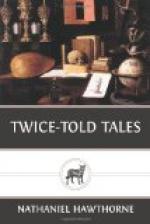of the latter class compelled him to give up his customary
walk at sunset to the burial-ground; for when he leaned
pensively over the gate, there would always be faces
behind the gravestones peeping at his black veil.
A fable went the rounds that the stare of the dead
people drove him thence. It grieved him to the
very depth of his kind heart to observe how the children
fled from his approach, breaking up their merriest
sports while his melancholy figure was yet afar off.
Their instinctive dread caused him to feel more strongly
than aught else that a preternatural horror was interwoven
with the threads of the black crape. In truth,
his own antipathy to the veil was known to be so great
that he never willingly passed before a mirror nor
stooped to drink at a still fountain lest in its peaceful
bosom he should be affrighted by himself. This
was what gave plausibility to the whispers that Mr.
Hooper’s conscience tortured him for some great
crime too horrible to be entirely concealed or otherwise
than so obscurely intimated. Thus from beneath
the black veil there rolled a cloud into the sunshine,
an ambiguity of sin or sorrow, which enveloped the
poor minister, so that love or sympathy could never
reach him. It was said that ghost and fiend consorted
with him there. With self-shudderings and outward
terrors he walked continually in its shadow, groping
darkly within his own soul or gazing through a medium
that saddened the whole world. Even the lawless
wind, it was believed, respected his dreadful secret
and never blew aside the veil. But still good
Mr. Hooper sadly smiled at the pale visages of the
worldly throng as he passed by.
Among all its bad influences, the black veil had the
one desirable effect of making its wearer a very efficient
clergyman. By the aid of his mysterious emblem—for
there was no other apparent cause—he became
a man of awful power over souls that were in agony
for sin. His converts always regarded him with
a dread peculiar to themselves, affirming, though
but figuratively, that before he brought them to celestial
light they had been with him behind the black veil.
Its gloom, indeed, enabled him to sympathize with
all dark affections. Dying sinners cried aloud
for Mr. Hooper and would not yield their breath till
he appeared, though ever, as he stooped to whisper
consolation, they shuddered at the veiled face so near
their own. Such were the terrors of the black
veil even when Death had bared his visage. Strangers
came long distances to attend service at his church
with the mere idle purpose of gazing at his figure
because it was forbidden them to behold his face.
But many were made to quake ere they departed.
Once, during Governor Belcher’s administration,
Mr. Hooper was appointed to preach the election sermon.
Covered with his black veil, he stood before the chief
magistrate, the council and the representatives, and
wrought so deep an impression that the legislative
measures of that year were characterized by all the
gloom and piety of our earliest ancestral sway.




